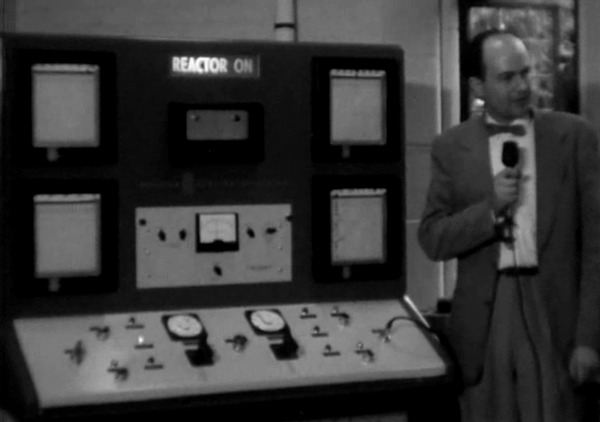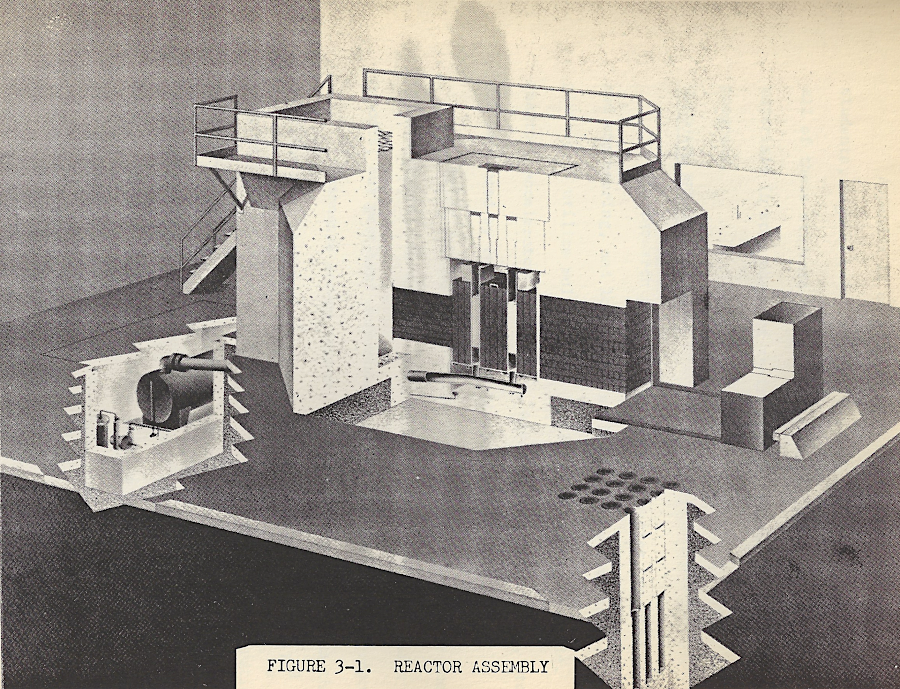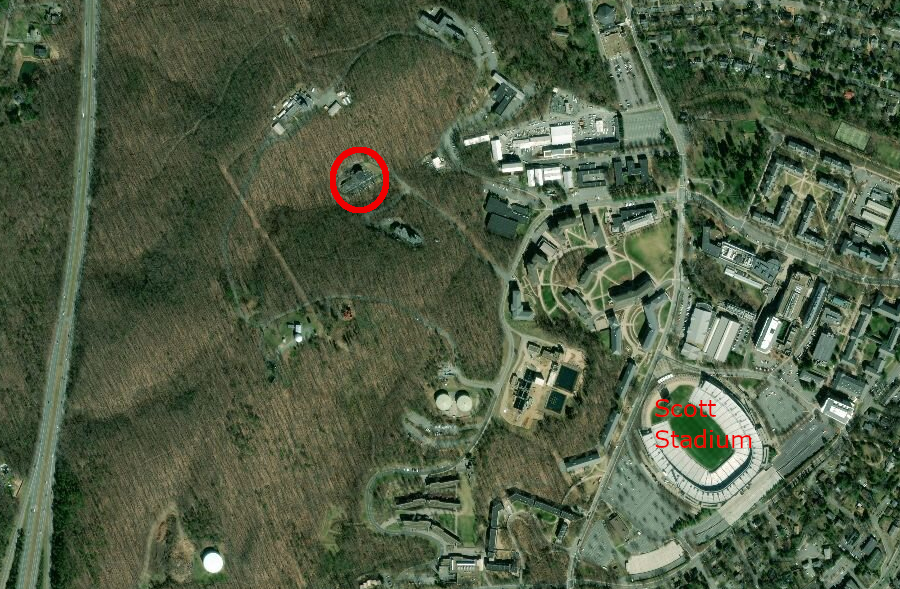Nuclear Reactors at Virginia Universities

in 1956, Roanoke television station WSLS-TV highlighted installation of the first simulator for reactor operations at a school in Virginia (Virginia Tech)
Source: WSLS-TV (Roanoke, VA) News Film Collection, 1951 to 1971, University of Virginia Library, Virginia Tech is first college to own nuclear reactor simulator
In 1956, Virginia Tech installed a Nuclear Reactor Simulator and a sub-critical "graphite-moderated exponential reactor" in Davidson Hall. They were the first at an American university.
Virginia Tech then acquired a research reactor with self-sustaining nuclear fission, without the need for protons accelerated by a particle accelerator. The initial reactor operated at 10 kilowatts (kW), then upgraded to 100kW. It was based on the Argonne National Laboratory's Argonaut design (Argonne Nuclear Assembly for University Training), developed to teach reactor theory and nuclear physics.
The reactor was located in Robeson Hall, which was built in the 1950's with Room 106 specifically designed to house the reactor. It operated from 1960-1981, generating heat from nuclear fission. The research reactor was never used to generate electricity.
When Tech's reactor was first built, peaceful uses of atomic energy were expected to create a demand for engineers to build nuclear power plants and for operators to manage the facilities. Ultimately, 70 teaching and research reactors were constructed in the United States before the accident at Three Mile Island interrupted plans by utilities to provide electricity generated at nuclear-fueled power plants, and limited the demand for universities to train more nuclear engineers.
There was one "event" during the operation of the research reactor. On November 12, 1971, a sample of radioactive material became stuck in a tube. Radiation alarms were triggered and the building was evacuated. The tube with the sample was quickly disconnected and placed inside the "hot cell," a shielded nuclear radiation containment chamber. One person received a 51 millirem radiation dose, srughly the exposure from a diagnostic x-ray.
Without a demand for graduates, the Virginia Tech reactor shut down in 1981 and was decommissioned five years later. When the reactor was dismantled in 1989, 70% of the concrete shield originally built to protect against release of radiation was placed in the local Blacksburg landfill. The 30% (68 tons) too radioactive to dispose of locally was shipped to an out-of-state facility for disposal as low-level radioactive waste. The uranium was recycled at the Savannah River Site.1

Virginia Tech operated a 100kW nuclear reactor for research and training students between 1960-1981
Source: Virginia Tech Special Collections and University Archives, Virginia Tech Atomic Energy Laboratories (January 20, 2023)
A professor at the University of Virginia used a high-speed centrifuge with uranium hexaflouride to study uranium enrichment by isotope separation, starting in 1948 or 1949. The work was done first in an annex to Rouss Hall (now incorporated into the McIntire School of Commerce). Later research was done in what became the Nuclear Reactor Facility, at the base of Observatory Hill in Charlottesville.
The enrichment research ended around 1985. The uranium and centrifuge were shipped to the Department of Energy at Oak Ridge, Tennessee.2
Two nuclear reactors were built for research and educating engineering students at the university's Nuclear Reactor Facility. The 2-megawatt University of Virginia Reactor (UVAR) was in operation between 1960-1998, fueled by a radioactive isotope of cobalt (Co-60). The 100-watt "Cooperatively Assembled Virginia Low-Intensity Educational Reactor" (CAVALIER) ran from 1974-1988.
In 2002, radioactive components at the facility were dismantled. Divers used plasma arc cutting equipment to cut up components in the reactor pool, using the water to minimize worker exposure to radiation. Low-level radioactive waste was shipped to Envirocare in Utah, and one shipment was sent to Barnwell, South Carolina for disposal.
Non-radioactive materials were recycled locally, including a 13,000-pound block of concrete that had been created sometime in the past but never moved or used for any known purpose. The building was converted into the Observatory Mountain Engineering Research Facility, and later served as the headquarters for the university's Solar Car Team.3
No Virginia educational institution operates a nuclear reactor today. Central Virginia Community College, located near Framatome and BWXT in Lynchburg, offers an associates degree in nuclear technology. The nuclear engineering program at Virginia Tech, which ran from 1956-2007, has been restarted. Since 2014, that university has offered PhD, Masters, and Masters of Engineering degrees in nuclear engineering.4

the Cooperatively Assembled Virginia Low-Intensity Educational Reactor (CAVALIER) was close to Scott Stadium
Source: ESRI, ArcGIS Online
Links
- Cavalier Daily
- Central Virginia Community College
- University of Virginia reactors
- Nuclear Regulatory Commission
- CH2MHill
- University of Virginia magazine
- Virginia Department of Health
- Virginia Tech
References
1. "Virginia Tech Atomic Energy Laboratories," Virginia Tech Special Collections and University Archives, January 20, 2023, https://scuablog.lib.vt.edu/2023/01/20/virginia-tech-atomic-energy-laboratories/; "Reactors Designed by Argonne National Laboratory," Argonne National Laboratory, https://www.ne.anl.gov/About/reactors/training.shtml; "The Cerenkov Blue - When U.Va. went nuclear," Virginia, University of Virginia, Summer 2006, http://uvamagazine.org/articles/the_cerenkov_blue; Frederick Gardner, Mark Manning, "Concrete removal and disposal from research reactor decommissioning," Waste Management Symposia 1986, http://www.wmsym.org/archives/1987/V3/76.pdf; "Virginia Tech once had its own nuclear reactor," Cardinal News,
April 10, 2023, https://cardinalnews.org/2023/04/10/virginia-tech-once-had-its-own-nuclear-reactor/ (last checked September 23, 2025)
2. "Waste Lands America's forgotten nuclear legacy," Wall Street Journal, http://projects.wsj.com/waste-lands/site/504-university-of-virginia-physics-department/ (last checked February 15, 2019)
3. P. F. Ervin, L. A. Lundberg, P. E. Benneche, Dr. R. U. Mulder, D. P. Steva, "University of Virginia Reactor Facility Decommissioning Results," Waste Management 2003 Symposium, February 2003, http://www.wmsym.org/archives/2003/pdfs/429.pdf; "
Observatory Mountain Engineering Research Facility," University of Virginia, http://www.virginia.edu/webmap/popPages/65-ObservatoryERF.html; P. F. Ervin, P. E. Benneche, R. U. Mulder, D. P. Steva, "Decommissioning Results and Lessons Learned at the University of Virginia Reactor Facility," Waste Management 2004 Symposium, March 4, 2004, http://www.wmsym.org/archives/2004/html/prof4240.html (last checked June 8, 2016)
4. "Nuclear Technology," Central Virginia Community College, https://centralvirginia.edu/programs-classes/science-technology-engineering-math/nuclear-technology; "History," Nuclear Engineering Program
Mechanical Engineering Department, Virginia Tech, https://nuclear.ncr.vt.edu/about/history (last checked December 16, 2024)
Energy in Virginia
Virginia Places


